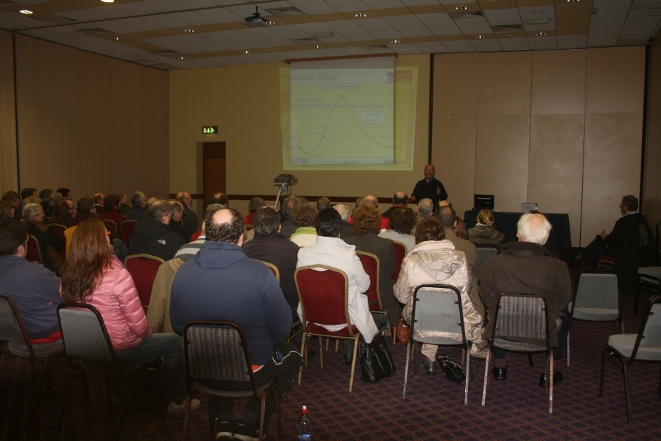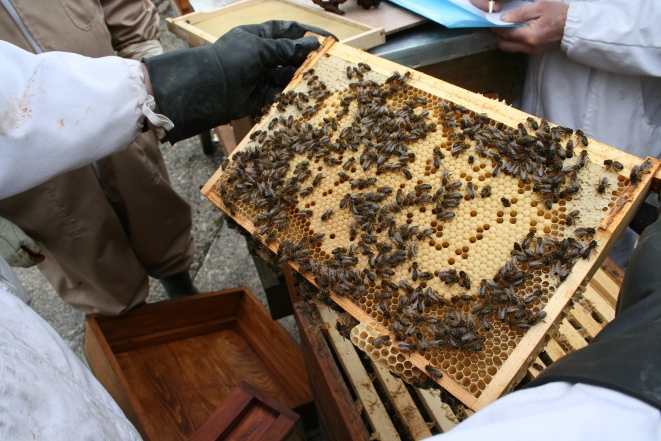County Limerick Beekeepers' Association
 Back to Notice Board
Back to Notice Board
Notes on the meeting of 10th Feb 2014
Subject: Spring Management
Speaker: Gerry Ryan
The speaker was Gerry Ryan who spoke on the subject of spring management. Here are just a few of the very many useful tips he gave us but please, if you are a beginner and have not yet signed-up for our beginners' course, do so as there is so much to learn and excellent as this talk was, there is no substitute for learning the basics thoroughly and systematically.
Gerry's first point was that Spring Management begins in the autumn! What we have done, or failed to do in the autumn will greatly influence the well-being of our bees in the spring. But in this summary of his talk, we will present the information starting with what we should be doing now in mid-February.
Part 1: What we can do now (in mid-February):
Each of the following can be done without opening the hive, that is without taking off the crownboard.
Prepare for Storms!
Gerry was speaking on the Monday night. On the Wednesday afternoon we had the worst storm in years. Gerry had warned members to check their hives and later Conan related how one of our own Association Apiary hives had blown over and been lost. It is best to make sure hives are well-secured with weights on the roof or straps securing the hive to stands - or both! In the longer term we might also be wise to think about how we could provide better shelter for our hives and if we are planning a new apiary, the storms should serve as a reminder to us to locate it if possible in an area with good shelter, especially from those prevailing westerly winds.
Heft and maybe feed.
Hefting the hive is feeling its weight as a means of estimating what stores of food the bees have left. Gerry showed us a chart  depicting how we are now entering the most critical period in the life of our colonies. That is, when the numbers of adult bees are continuing to dwindle after the winter to the point where hungry larvae and grubs actually outnumber the adult bees whose job it is to feed and take care of them. Good conditions are so important now and if we are unlucky enough to have very cold, wet or windy weather our care, in the form of feeding in particular, may make all the difference to a colony's survival.
depicting how we are now entering the most critical period in the life of our colonies. That is, when the numbers of adult bees are continuing to dwindle after the winter to the point where hungry larvae and grubs actually outnumber the adult bees whose job it is to feed and take care of them. Good conditions are so important now and if we are unlucky enough to have very cold, wet or windy weather our care, in the form of feeding in particular, may make all the difference to a colony's survival.
So the next point one should take particular note of from Gerry's talk is that we make sure that our bees have adequate stores, something Gerry had already mentioned that we should have also taken care to do in the autumn. Gerry said that this year at least, the job for many of us has most likely been made a lot easier by the good end we had to last season when there was plenty of nectar and pollen available for the bees to collect and we had the weather for them to do so. The bees need the nectar to give them energy to see them through the winter and pollen to give the hatching bees protein which they need in order to grow. Gerry also pointed out that in spite of all the bad weather we've been having, it has nonetheless been very mild for the time of year and the willow and hazel catkins loaded with that all-important early pollen is already to be seen in the hedgerows. In spite of this, it is still as well to make an estimate of the bees' stores by "hefting" our hives. That is, by lifting one side of the hive and then the other, in order to feel its weight. If both sides of the hive feel light, the bees need feeding.
If we do decide to feed, then the subject of what to feed becomes important. At this time of the year, when it is still comparatively cold, it is best to feed fondant or even better, a purpose-made bee food like Apifonda. Both these types of food can be cut into slabs. Each slab needs to be wrapped in clingfilm or plastic to stop it from drying out. Some slits are cut into the plastic through which the bees take the food. The slab is placed over the feedhole in the crownboard. An eke or empty super is placed on top. Gerry fills up the empty space in the super with insulating material like old jumpers or newspaper. One need only then check from time-to-time if more is needed. Generally, if the food is being taken, that is a sign that it is needed as bees normally prefer to forage.
Gerry did give us a very simple recipe for making our own fondant. I'm not going to include this recipe here as Gerry made clear that if heated for too long, there is a risk that the resulting feed can cause digestive problems for the bees. And while on the subject of feeding harmful brews, Gerry also warned against the feeding of old syrup to bees. This may well have fermented and cause sickness.
Examination of the hive exterior and varroa tray.
We can look out for signs of disease which may be apparent from drowsy-looking bees crawling about in the grass around the front of the hive. Also at the front of the hive, soiling with brown spots is an indication of dysentry. If the weather is fine, are the bees out on a cleansing flight or foraging (perhaps for that willow pollen) as they should be?
We should also check the varroa tray, not just to do a mite count but there also will be signs of what is going on within the hive from what falls on to it. The mite count should be no more than two per day. In relation to varroa, Gerry welcomed the arrival and approval of a new formic acid-based treatment which is soon to become available. The brand name is MAQS®.
One final point in relation to disease: if we do seem to have lost a colony, we should take careful steps to confirm this for sure. And if the hive 'is no more', we should block the entrance so that other bees cannot enter and possibly pick up disease and then remove the hive from the apiary altogether. If we suspect disease, we should send a sample of dead bees to Mary Coffey.
Our plans for the year ahead
Something to be doing at this time of the year, (if not before!) is to be making your plans for the coming season. We cannot plan the weather but we can be ready for good weather if it comes, by making sure for example, that we have all the hives, nucs, frames and foundation that we might need, prepared or in store. We should make sure that all our basic equipment is ready and easily located and preferably put into one or two bags, boxes, baskets or similar so that everything can be gathered readily. If we have to travel to some of our hives, this is doubly true. We should also try to be clear as to what we are aiming to achieve in the season ahead with regard to any increase in the number of hives/nucs.
Back to topBack to Notice Board
Part 2: The First Inspection
The first inspection of the year has to wait until the weather is warm enough (above 15°C) and this is usually about mid-April. This inspection should only take about two or three minutes.
The first thing to check is that the queen is laying: that is that each colony is still "queen right". To do this we need only see that there are eggs, larvae or grubs present. There is no need to find the queen. The queen should have been laying in the autumn, she should certainly be laying again by the time we make our first inspection and in fact, she should have recommenced laying already now, in mid-February, even though it is much too early for us to check that she is.
Another point to bear in mind is the pattern of the brood. A fairly nice brood pattern such as the one pictured below should be seen - the capped brood cells are the yellow ones in the centre of the frame. If the brood pattern is formed in a hap-hazard manner or if there are too many empty cells (more than 15%), remedial action will be necessary; that is, requeening or amalgamation.
should be seen - the capped brood cells are the yellow ones in the centre of the frame. If the brood pattern is formed in a hap-hazard manner or if there are too many empty cells (more than 15%), remedial action will be necessary; that is, requeening or amalgamation.
Gerry also emphasised the need for hygiene and recommended the removal of old comb from the hive saying he aims to completely replace with new frames and foundation, at least two of the worst old frames per hive each year.
Ivy Honey
Just one further of Gerry's very many valuable tips we will mention here: A method to make it easier for the bees to use ivy honey: when inspecting the hive, take out two frames of ivy honey, scrape off the cappings and dip the frame into a tub of clean water and put the wet frame back inside the hive. If they are not emptied by the bees after 2 days, take them out and store them. Bees would normally have to work to collect water in order to hydrate ivy honey. If we do this we will save our bees work and they will have more time and energy to spend taking care of themselves, their queen, brood and to spend making honey.
Keith
Photos by Frank Corbett